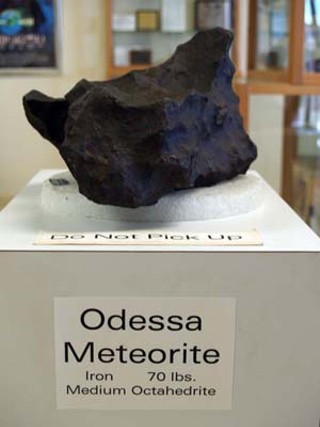Day Trips
The Odessa Meteor Crater is the site of a serious intergalactic impact
By Gerald E. McLeod, Fri., April 18, 2008

The Odessa Meteor Crater wouldn't have looked like much more than a shallow indentation on the flat landscape to the first people who saw it. Long before I-20 dissected the Permian Basin, the second-largest meteorite crater in the U.S. looked more like a West Texas buffalo wallow than the site of a serious intergalactic impact.
"You can see where the rock has been turned up by the explosion," says Bob Rice, caretaker of the 10-acre site for Ector County. The collision with an extraterrestrial rock happened some 50,000 years ago.
By the time cattlemen arrived, the 100-foot-deep bowl had filled in to about 6 feet below the rim with sand and dirt from the surrounding desert. A local rancher discovered the depression while looking for a lost calf. He thought it was a blowout hole caused by gases escaping from below the surface.
It wasn't until a visiting geologist noticed a volcaniclike rock found at the site, being used as a paperweight on a desk, that anybody recognized the possibility of a meteorite strike. In 1922, Dr. Elias Sellards identified the crater while looking for a commercial quantity of potash. "We still get scientists visiting from around the world," Rice says.
Up until World War II, the University of Texas and other entities conducted scientific studies at the site. Several feet of sediment were excavated from the partially filled 550- to 650-foot-diameter crater. Standing on the edge of the blast zone, under the shade of a picnic pavilion, you can easily see the indentation caused by the falling meteor.
In the center of the depression is a concrete slab surrounded by a fence, the remainder of a 165-foot shaft dug to look for the remains of a meteorite. Scientists never found a main meteorite because it hit with such velocity that it nearly vaporized on impact. "The biggest chunk ever found in the main crater was about 300 pounds," Rice says.
A smaller crater next to the main crater has a 6-ton piece buried at the bottom, he says. There are three other craters in the vicinity. Each was formed during a shower of rare nickel-iron or metallic meteorites. Most outer space rocks that make it through our atmosphere are small and resemble rocks found on earth.
A dirt path takes visitors down one side, across the bottom of the crater, up the far side, and along the rim for a complete view of the explosion site. From the bottom, the hole looks massive, and the jagged rock walls point in every direction. The visitors center towers overhead like a lighthouse.
If you have even a passing interest in meteoritics or geology, then the small museum at the park offers big surprises. Along with the hundreds of samples of heavenly formed rocks is a meteorite found in Argentina sliced so thinly that light shines through its light-green quartz. A volleyball-sized piece of meteorite found in the crater looks like molten iron and weighs 70 pounds. There is even a piece of a Martian meteorite on display.
Scientists guess that the meteorite that hit near Odessa was probably debris from the asteroid belt between Mars and Jupiter. Meteorite craters are exceptionally rare because the falling debris is seldom large enough to be found without metal detection equipment.
Meteor Crater outside of Winslow, Ariz., claims the prize as the largest meteorite crater in North America. Formed about the same time as the Odessa crater, the Arizona blast site is 550 feet deep, 4,000 feet across, and 2.4 miles in circumference. The family that discovered the crater still operates the remote site as a tourist and learning facility with a restaurant, a gift shop, movies, and tours.
The Odessa Meteor Crater is about three miles west of the city limits and two miles north of I-20 on Meteor Crater Road. Admission is free, but donations are cheerfully accepted in the tip jar. The gates are open Tuesday-Saturday, 10am-5pm, and Sunday, 1-5pm. "Tell everybody we're sometimes open on Monday, but you can't count on it," Rice says. To get more information, call 432/381-0946 or go to www.nwol.net/virtdomains/meteorcrater.
876th in a series. Day Trips, Vol. 2, a book of "Day Trips" 101-200, is available for $8.95, plus $3.05 for shipping, handling, and tax. Mail to: Day Trips, PO Box 33284, South Austin, TX 78704.








